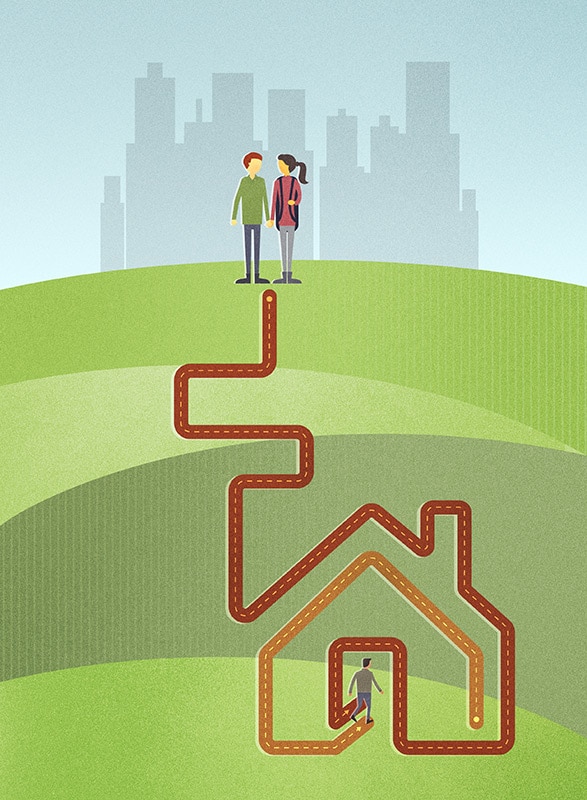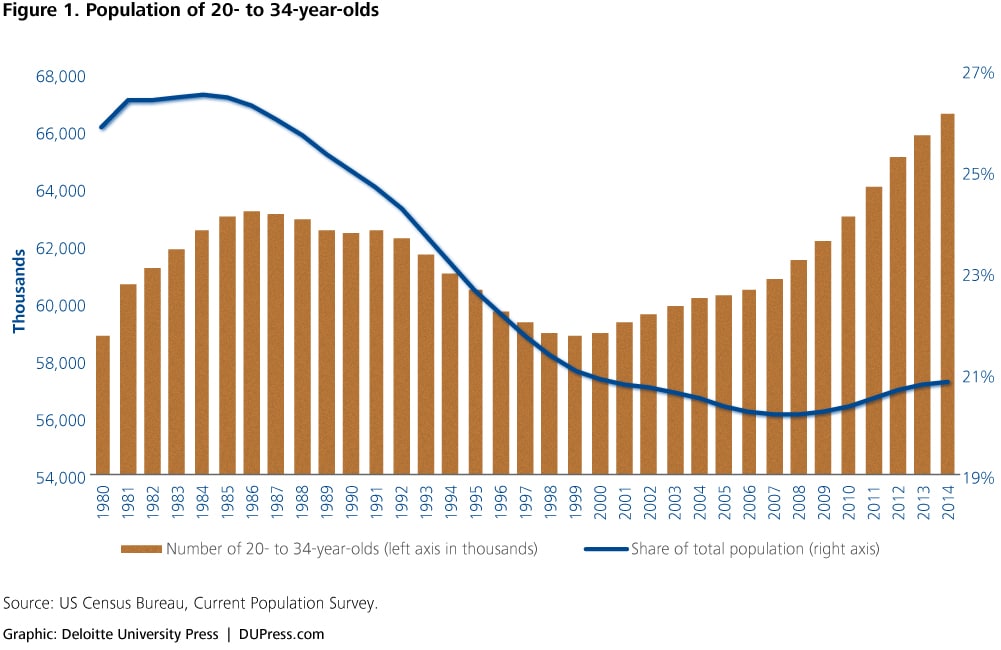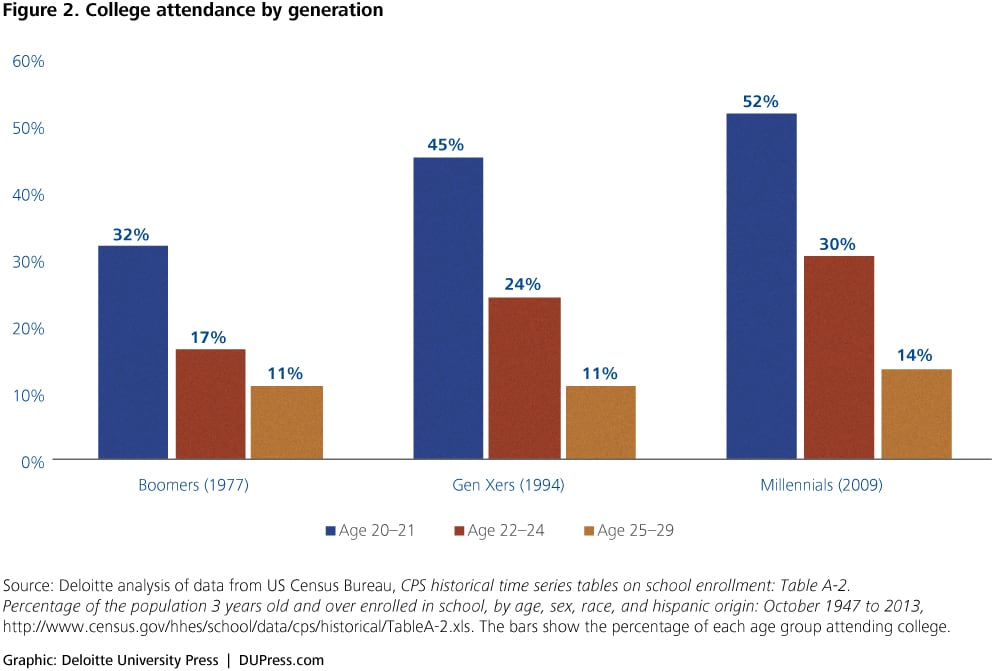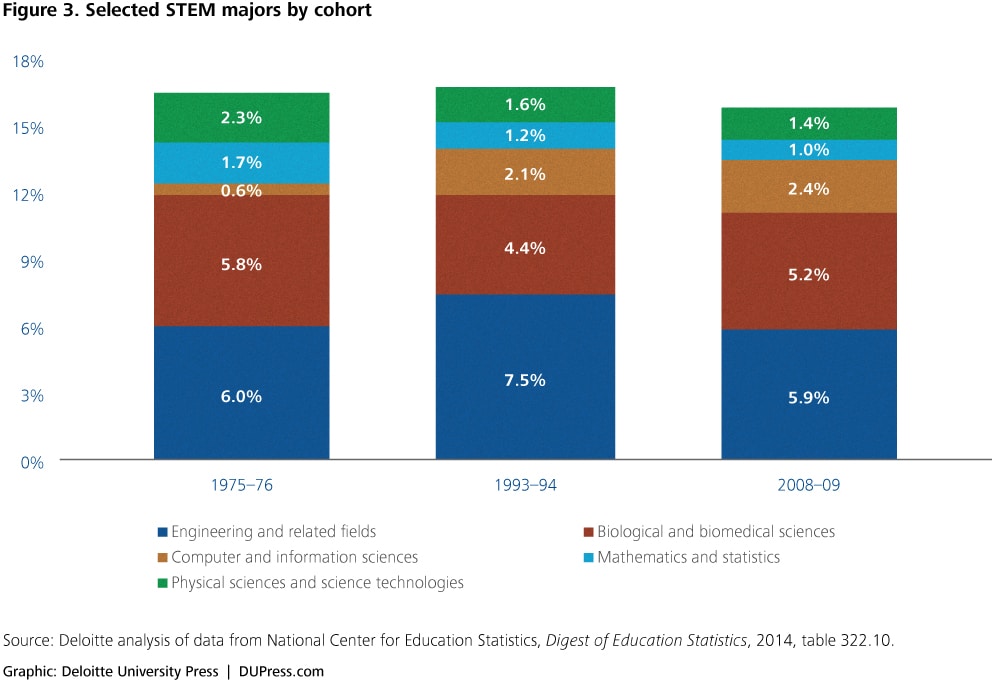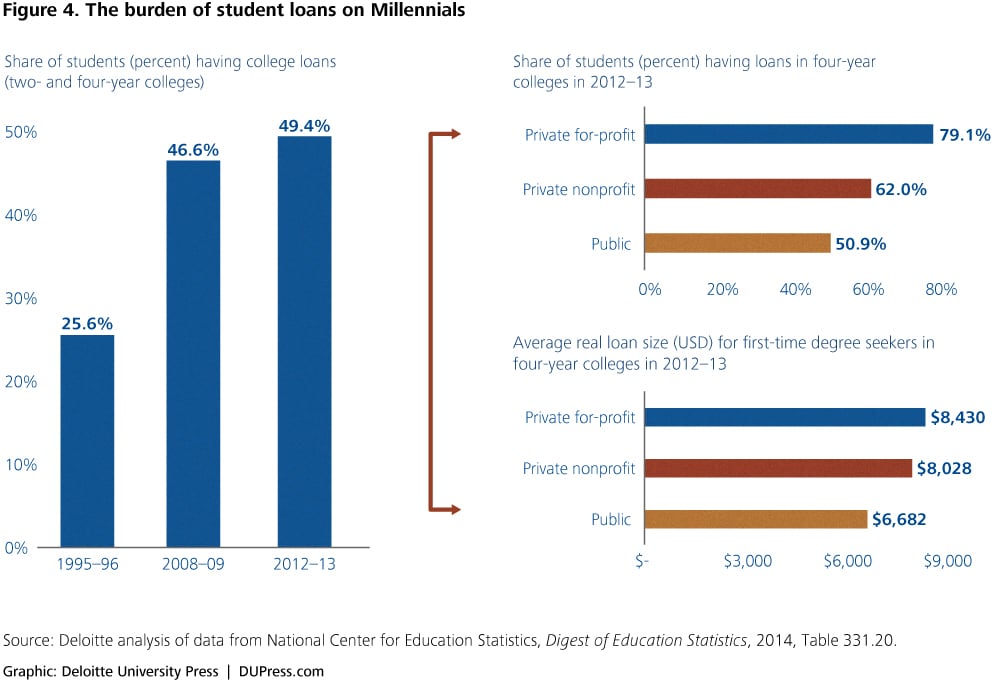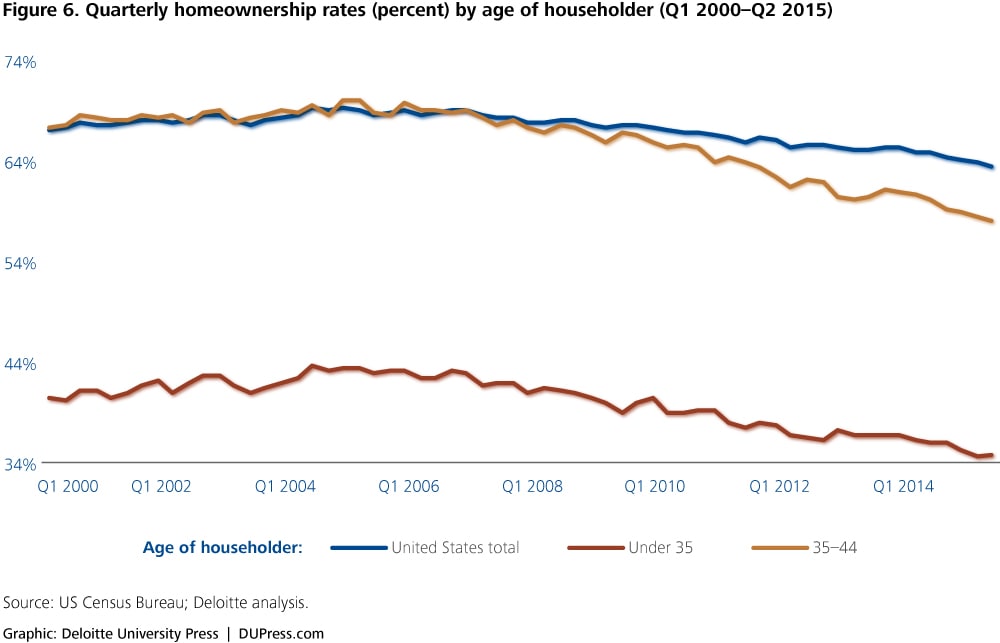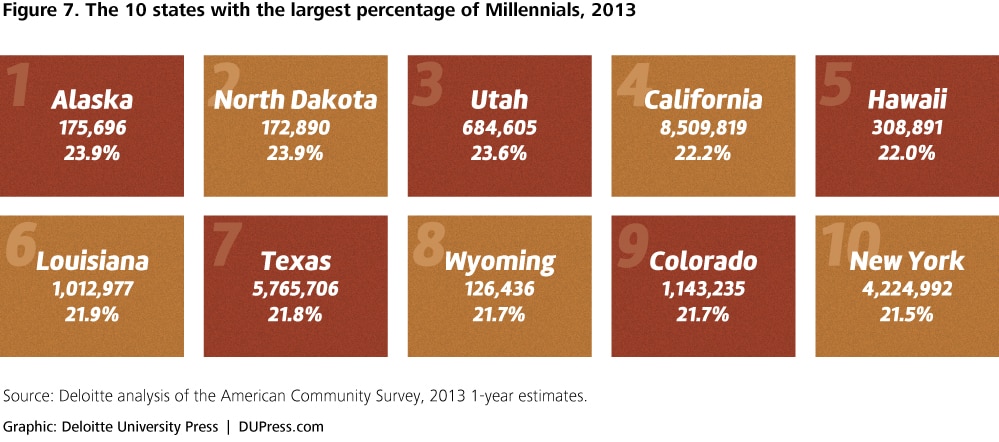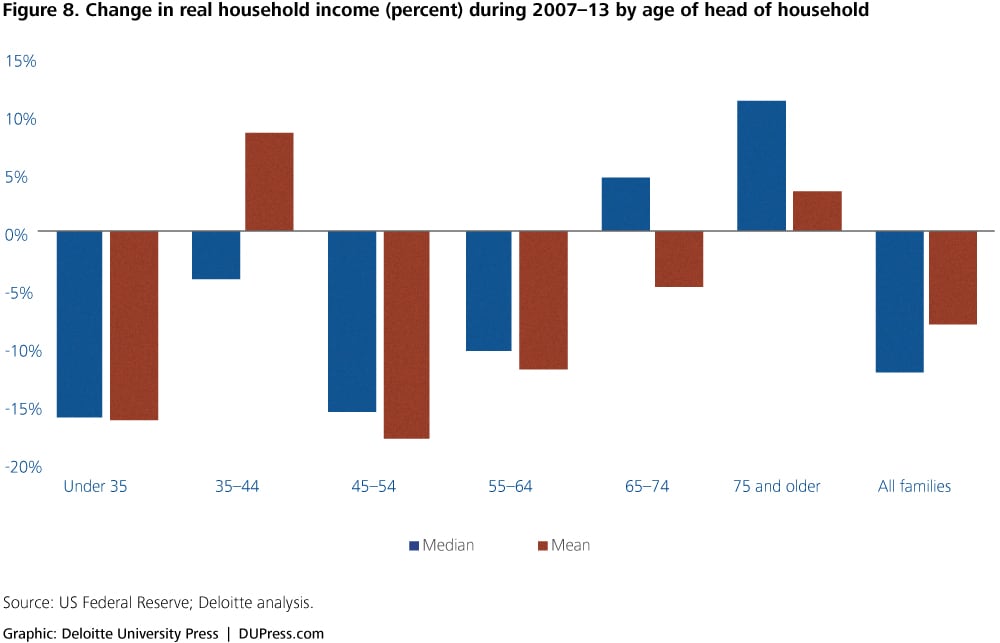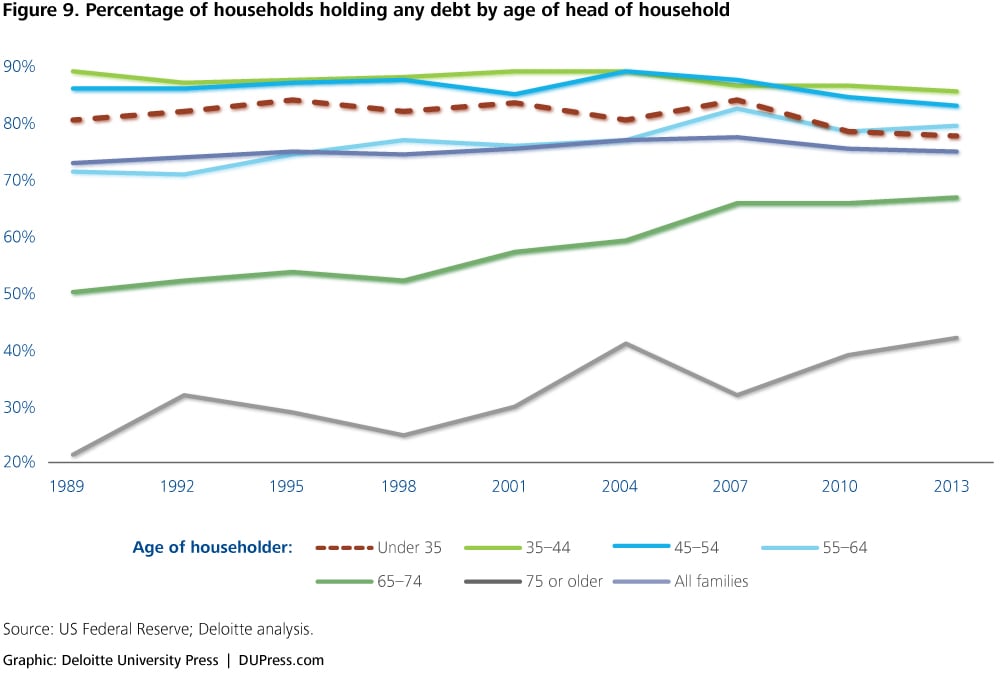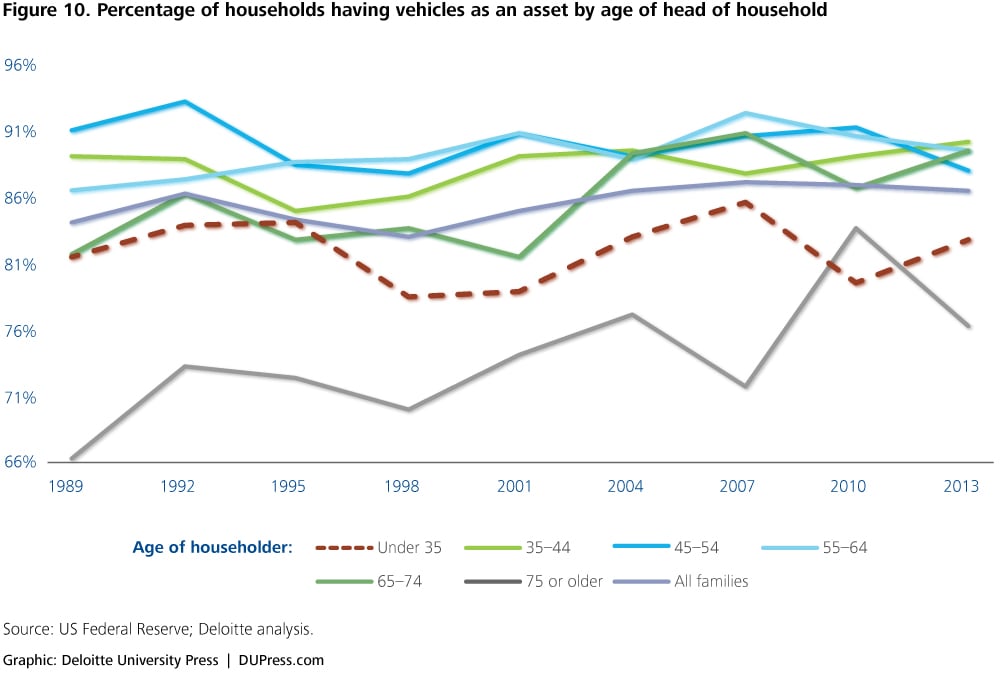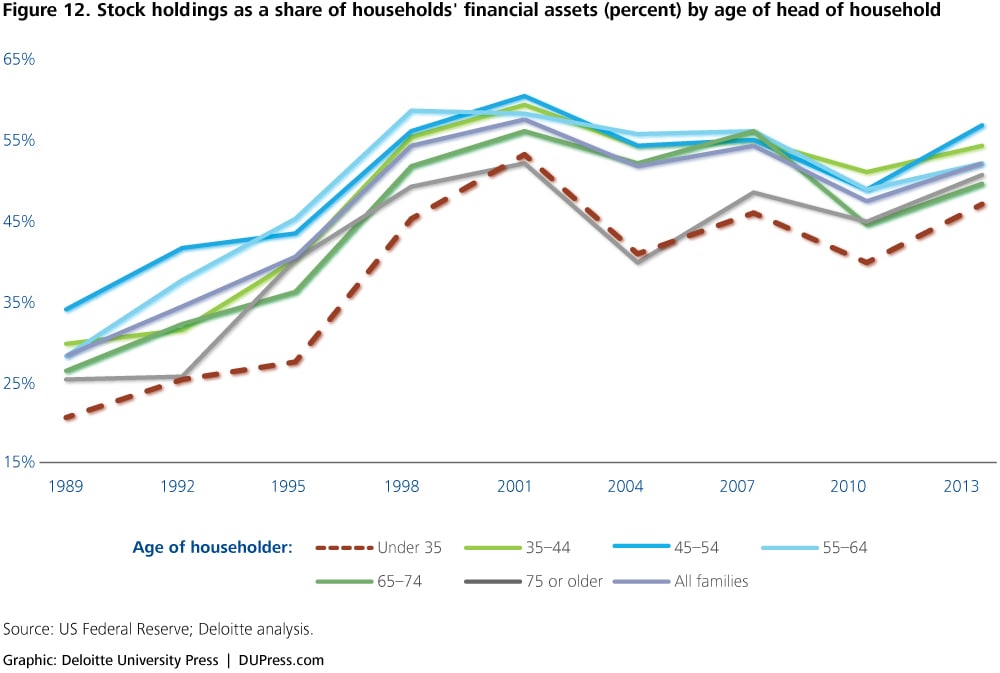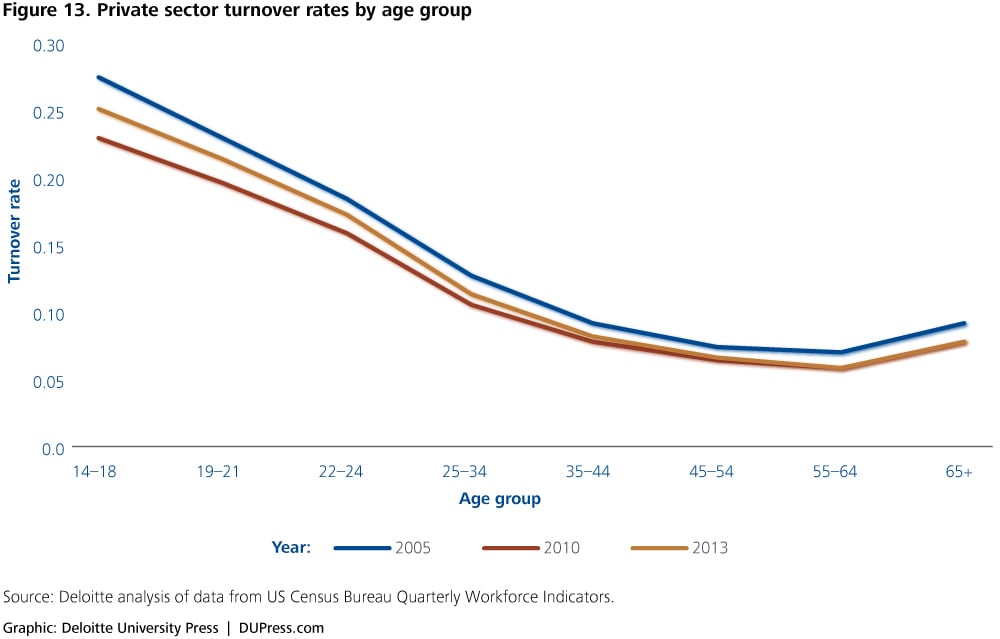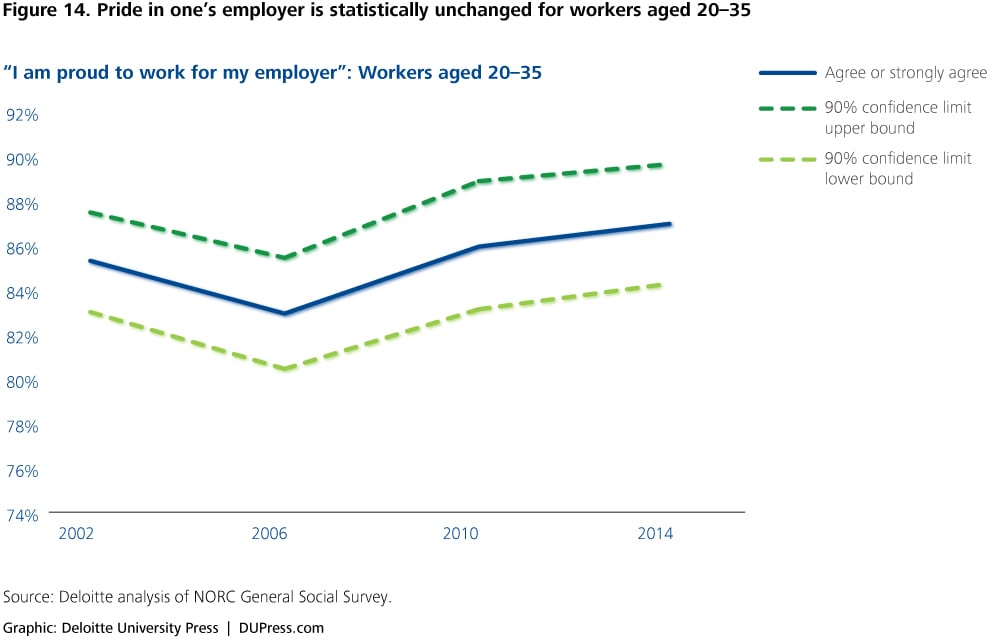A new understanding of Millennials: Generational differences reexamined has been saved

A new understanding of Millennials: Generational differences reexamined Issues by the Numbers, October 2015
17 October 2015
Millennials are widely thought to be less loyal to their employers than their older colleagues. But a look at the numbers suggests that many of the traits attributed to Millennials are related to prevailing economic conditions rather than to fundamental differences in their aspirations.
The behavior of Millennials has been shaped by two major factors: the Great Recession, which hit them harder than it hit older generations, and explosive growth in student debt. However, other observed differences in their behavior—differences that set Millennials apart from people of similar age in prior years—largely reflect trends that have impacted all age groups, not just Millennials. The hallmarks of the American dream, such as cars and homeownership, are more a dream deferred than a dream abandoned for Millennials. A better understanding of how external factors are affecting the timing of Millennials’ transitions can help employers craft programs to address the needs of this challenging group.
View related infographic online
Click hereUnderstanding Millennials
In the United States, economists, businesses, and policymakers have been studying demographics intensely since World War II. Indeed, following the war, a new unit of measurement arose: the labeled generation. The Baby Boomers—those born between 1946 and 1964—were the first generation to adopt a widely accepted label. Then came the Gen Xers, followed by the Millennials (sometimes referred to as Gen Y). Though there is no universally accepted definition, the term “Generation X” is often applied to those born roughly between 1965 and 1980, and “Millennial” to those born between 1980 and 1995.1
Millennials have been widely studied, with numerous surveys highlighting ways in which they differ from older generations. For example, a survey by Pew Research Center revealed that Millennials are much more likely than Boomers and Gen Xers to describe themselves as political independents.2 Another survey by Deloitte found that Millennials wanted businesses to focus more on “people and purpose.”3 No wonder, then, that many studies on Millennials, especially those on workforce patterns, are driven by concerns that Millennials may be following radically different career trajectories than prior generations.
As we describe below, Millennials are indeed different from prior generations of young people in a number of ways. For example, Millennials are living at home longer, are slower to buy a car, and are much more likely to have student debt. However, other than their high levels of student debt, many of the attributes associated with Millennials are related to the economic conditions prevailing at the time when they came of age (like the Great Recession) rather than fundamental differences in their aspirations. This has implications for human capital strategies, especially regarding the advantages to employers of taking a “customer segmentation” approach toward Millennials. It also can inform strategies for how federal, state, and local governments can overcome some of the perceived difficulties in attracting and retaining Millennials in their workforces.
Who are the Millennials?
Numerous, diverse, highly educated, and drowning in student loan debt
Numbering over 66 million, the current group of 20- to 34-year-olds—although they make up a smaller proportion of the total population than the Boomers—is the largest ever in the United States (figure 1). Because Boomers are now moving into retirement and Gen Xers are fewer in number, Millennials have recently inched past the other generations to corner the largest share of the labor market (they make up 32.0 percent of the labor force, compared to 31.2 percent for Gen Xers and 30.6 percent for Boomers).4 Millennials display greater diversity than older generations: 44.2 percent are classified as being in a minority group (that is, a group other than non-Hispanic white).5
Numbering over 66 million, the current group of 20- to 34-year-olds—although they make up a smaller proportion of the total population than the Boomers—is the largest ever in the United States.
The Millennials are also more highly educated than those in earlier generations. Figure 2 shows college enrollment rates among young people in 1977, 1994, and 2009, representing enrollment among Boomers, Gen Xers, and Millennials, respectively. As the figure shows, the college enrollment rate among Millennials in all age groups is higher than the rate for either older generation. Completion rates are also increasing, with 39.4 percent of those starting at a four-year institution in 2007 graduating in four years and 59.4 percent graduating within six years.6
Even though a higher proportion of Millennials are choosing to attend college, they are not showing an increased inclination to major in high-demand areas of science, technology, engineering, and mathematics, the STEM fields. Figure 3 shows that, despite decades of rhetoric highlighting the need for more STEM graduates, only a slightly higher proportion of Millennials than Gen Xers are graduating with majors in biological and biomedical sciences and computer and information sciences. Millennials proportionately trail Boomers in all STEM majors except for computer and information sciences. Instead, many Millennials are choosing to major in business (21.7 percent), social science and history (10.5 percent), health professions (7.5 percent), and visual and performing arts (5.6 percent).7(To dig deeper into the proportions of STEM and non-STEM majors, view our interactive version of figure 3.)
Student loans have persistent effects on Millennials’ economic choices
Higher college attendance among Millennials does not come close to explaining the defining characteristic of the generation—the explosion in student debt. During the 1995–96 school year, the approximate midpoint of when the Gen Xers were in college, 25.6 percent of all undergraduates at two- and four-year colleges had student loans.8 By the 2008–09 school year, that percentage had grown to 46.6 percent. For the most recent school year, 2012–13, the proportion further expanded to 49.4 percent.9 These percentages were significantly higher at four-year institutions (figure 4). (For more detail on student loan debt levels, view our interactive version of figure 4.)
Not only are more students taking out student loans, but the size of the loans themselves has been growing rapidly. Between the 2001–02 and 2012–2013 academic years, the average loan size for first-time degree-seeking undergraduate students at public institutions grew by 55 percent in real terms to $6,682, while the average loan size at private nonprofit institutions grew by 50 percent to $8,028. The rate of increase at private for-profit institutions was lower, but the average loan size at these institutions, at $8,430, still exceeded the average loan size at private nonprofit institutions.10 Large increases in student loan debt levels occurred in the years when the Great Recession was at its height, though we have no direct evidence that the recession itself caused the changes in debt levels. It is possible that increases in student debt resulted from constraints on parental finances due to the recession.
Before the recent explosion of student debt, young people with student loan debt were actually more likely to take on other types of debt. To lenders, student loan debt has traditionally signaled that an individual had a college degree that increased earning potential. This is why, until recently, 25-year-olds with student loan debt were also more likely to have auto and home debt than those without student loan debt. That trend has changed in recent years. Now, 25-year-olds with student loan debt are less likely than their student loan debt-free peers to have a mortgage or auto loan.11
Related to this situation has been the rise in student default rates. As shown in figure 5, overall default rates on student loans after three years is just over 11 percent, although the ranges by school type vary considerably.
Economic forces constrain Millennials from finding good jobs and forming households
Poor job prospects, as well as high levels of student debt, mean that a sizable portion of the Millennial generation has started out with distinct disadvantages. The Great Recession hit younger workers particularly hard. At its worst in October 2009, when overall unemployment hit 10.0 percent, the unemployment rate for 20- to 24-year-olds was 15.8 percent; for 25- to 34-year-olds, the unemployment rate was 10.6 percent, while for those over 35, it was 7.9 percent. Although unemployment rates among Millennials have improved since then, they remain high today at 9.1 percent for 20- to 24-year-olds and 5.1 percent for 25- to 34-year-olds. The unemployment rate for the 35-and-older group was 3.8 percent in September.12
Poor job prospects, as well as high levels of student debt, mean that a sizable portion of the Millennial generation has started out with distinct disadvantages.
The combination of high unemployment, high student loan debt, and the bursting of the housing bubble caused homeownership rates to fall even more sharply since 2007 for those under 35 years of age than among the population as a whole (figure 6).13 These factors also hit household formation. For example, the percentage of 18- to 24-year-olds living with their parents went up to 54.9 percent in 2014 from 49.5 percent in 2005, while the percentage of 25- to 34-year-olds living with their parents went up to 17.7 percent in 2014 from 13.5 percent in 2005.14 The fall in Millennial homeownership during the period 2007–2013 is also evident from a five-percentage-point decline in the share of households having a primary residence as an asset in the under-35 cohort.15(For more information on home ownership trends, view our interactive version of figure 6.)
Millennials’ location choices are driven by economic realities
States with the highest current proportions of Millennials (aged 20–34 in 2013) are shown in figure 7. Topping the list is a mix of states with strong higher educational systems (California, New York), states offering attractive “lifestyle” options (Alaska, Utah, Hawaii), and states that experienced energy booms and associated job growth in the 2000s (North Dakota, Wyoming, Texas). States with large military bases also have higher concentrations of Millennials.
Many Millennials wish to relocate, and the time after graduating from college has traditionally been a common time for Americans to move. Certain cities seem to be “magnets” for Millennials, offering just the right combination of labor market, housing, transportation, cultural, and educational opportunities. Washington, DC continues to lead the nation in attracting Millennial in-migration, according to an analysis by the Brookings Institution, followed by Denver, Portland (OR), and Houston.16 But Millennials—who continue to make up the majority of internal migrants in the United States17—have seen their horizons limited by the Great Recession. Since 2007, Millennials have continued to move less than prior generations did at similar ages. In contrast, migration among senior citizens has almost recovered to pre-recession levels.18
Millennials behave similarly to others once they form households
There is no doubt that the Great Recession affected households headed by Millennials. For example, incomes of households headed by Millennials fell after 2007, and as a result, the cohort has hesitated to take on large amounts of debt. However, these trends are not limited to Millennial-led households. Once they form households, Millennials display economic behavior similar to other cohorts. We examine these economic trends in more detail below.
Incomes for households headed by Millennials have gone down, but they are not alone
We can see how Millennial incomes were affected by the 2007 crash by analyzing the triennial Survey of Consumer Finances (SCF). Comparing real income from SCF for households age 35 and under reveals that these households experienced the sharpest decline in median income between 2007 and 2013 (16 percent), but they did only slightly worse than households headed by 45- to 54-year-olds (figure 8).
When we focus in on the last three years, we find an interesting pattern. Income inequality for the under-35 cohort fell during 2010–2013, in contrast to the pattern among all US households.19 This tells us that, unfortunately, lower income inequality for the under-35 cohort has come at the cost of overall income.
Households in the under-35 cohort have been taking on less debt since 2007 . . . except for student loans
The decline in the share of mortgages among households in the under-35 cohort is in line with a lower preference for debt among this cohort and some others (35–44-year-olds and 45–54-year-olds). Indeed, the Great Recession, with its detrimental impact on wealth and income, brought down both the ability and the inclination to take on debt among households headed by Millennials. Between 2007 and 2013, the share of households in the under-35 cohort holding any form of debt fell by 6.5 percentage points—the largest decline among all cohorts (figure 9). During the same period, the median value of household debt also fell by the greatest amount among the under-35 cohort (23 percent).20 This is not surprising, given the steep decline in income for this cohort after 2007 (figure 8). Notably, with the economy in recovery since 2010, debt levels have stabilized for some cohorts (including the under-35 cohort) and risen for others.21(For more information on household debt trends, view our interactive version of figure 9.)
In addition to mortgages, vehicle loans fell after 2007 among households headed by Millennials. The proportion of households in the under-35 cohort holding vehicle debt fell by 12.1 percentage points between 2007 and 2010. Since 2010, however, this proportion has increased somewhat among the under-35 cohort, similar to the trend among some other cohorts. Credit card debt has also decreased since 2007 among those under 35—but it would be wrong to say that this decline is a purely post-2007 trend. The share of households in the under-35 cohort holding credit card debt has been declining steadily since 1995.
Not interested in cars? Not really
Multiple survey results have pointed to Millennials’ lower preference for vehicle ownership. Data on household finances from SCF add some nuance to these findings, showing that, while the percentage of those under 35 who own vehicles is indeed smaller than the comparable percentage among older cohorts, car ownership among the under-35 cohort is by no means dead. For example, although the share of households with a vehicle as an asset among the under-35 cohort fell by six percentage points between 2007 and 2010, this percentage has recovered since then (figure 10). (For further information on vehicle ownership among different generations, view our interactive version of figure 10.)
Millennial equity ownership is holding steady over time
In the immediate aftermath of the Great Recession, equities lost much of their popularity. Nevertheless, the share of households in the under-35 cohort that held stocks as an asset has remained fairly stable since 2007 (figure 11). This contrasts somewhat with the pattern for other age groups, among whom equity ownership has been more volatile. Also, between 2007 and 2010, the value of stock holdings (both direct and indirect) as a percentage of total financial assets declined for all households. But falling equity prices had as much to do with this as did changes in household stock holdings. Moreover, since 2010, the value of stocks as a percentage of total financial assets has recovered among all households, including those headed by Millennials (figure 12).
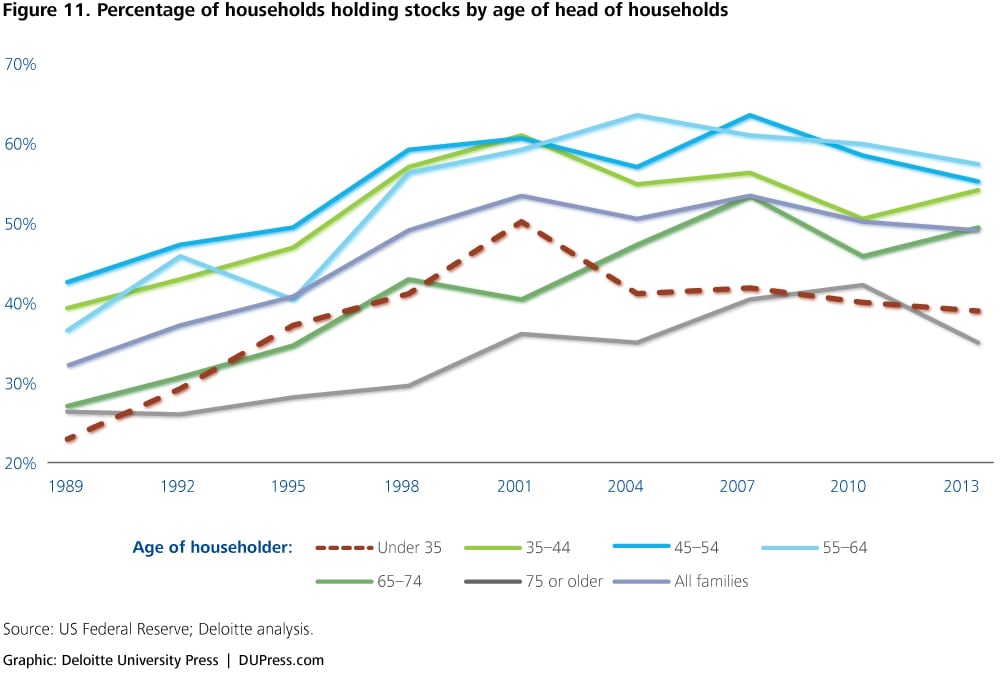
Millennials in the workforce
Job-hopping among Millennials: By choice or by necessity?
Conventional wisdom holds that Millennials are less loyal to employers than those in other generations, and that they won’t stay in the same job for more than a few years.22 Polls often paint a dispiriting picture of Millennials as flighty employees, unwilling to work hard in a single job over the long haul, and too ready to chase the next opportunity for personal fulfillment.23 When we look at hard numbers, however, we find that Millennials’ rate of job change is not substantially different from that of prior generations.
Most of the evidence for perceived higher Millennial turnover rates appears to be a misinterpretation of age effects. As was the case with Boomers and Gen Xers, young people today tend to switch jobs more often than older workers, particularly before they settle down and have kids. It’s also true that Millennials are both entering the labor market and forming households later than their predecessors did. Taking these two facts together gives us a ready explanation of why Millennials’ period of job-hopping is occurring later in their lives.
Many labor market economists believe that there are two primary determinants of how often employees switch jobs: long-term trends in the US job market’s fluidity,24 and shorter-term business cycles. When the economy is growing, more jobs are available, and more workers of all ages are willing to take a chance and jump to another job. When the economy is shrinking, the opposite is true, and workers of all ages tend to hang on to the job they have.
Figure 13 shows age-specific turnover rates for all US private-sector workers at three time points: 2005, 2010, and 2013. Particularly instructive is the portion of the x-axis showing turnover rates for workers aged 19 to 34. In 2005, this age cohort was made up of Generation Xers. In 2013, this same age group was made up of Millennials. If Millennials truly had fundamentally different views on job-hopping, we would expect to see different turnover rates and different slopes for the lines representing these age cohorts. Instead, we see almost exactly the same slope for all three years, simply shifted upward when the economy was booming (2005) and downward as it contracted (2010). (For more information on turnover rates, view our interactive version of figure 13.)
Millennials’ attitudes toward employers: Fluid until they settle down
Paralleling our findings about Millennials’ borrowing and purchasing patterns, we find that once Millennials do enter the workforce, their attitudes toward their employers look quite similar to those of previous generations. Pride in one’s employer among 20- to 35-year-olds has remained statistically unchanged in the years between 2002 and 2014, according to the NORC General Social Survey25 (figure 14).
Paralleling our findings about Millennials’ borrowing and purchasing patterns, we find that once Millennials do enter the workforce, their attitudes toward their employers look quite similar to those of previous generations.
The conventional wisdom that Millennials are less loyal to their employers than other generations may be an artifact of Millennials’ incomplete entry into the labor market. Many are still relying on seasonal or temporary work while struggling to pay off mounting student loans. Supporting this speculation is that, among those 20- to 34-year-olds who are not heads of households—a proxy for marginal labor market status—we do see a trend toward less pride in their employer (figure 15). In 2014, for the first time, non-household heads aged 20–34 indicated less pride in their employer than heads of household of the same age at a statistically meaningful level (90 percent confidence level). It is too early to tell whether this difference will persist. (To dig deeper into trends in organizational pride, view our interactive version of figure 15.)
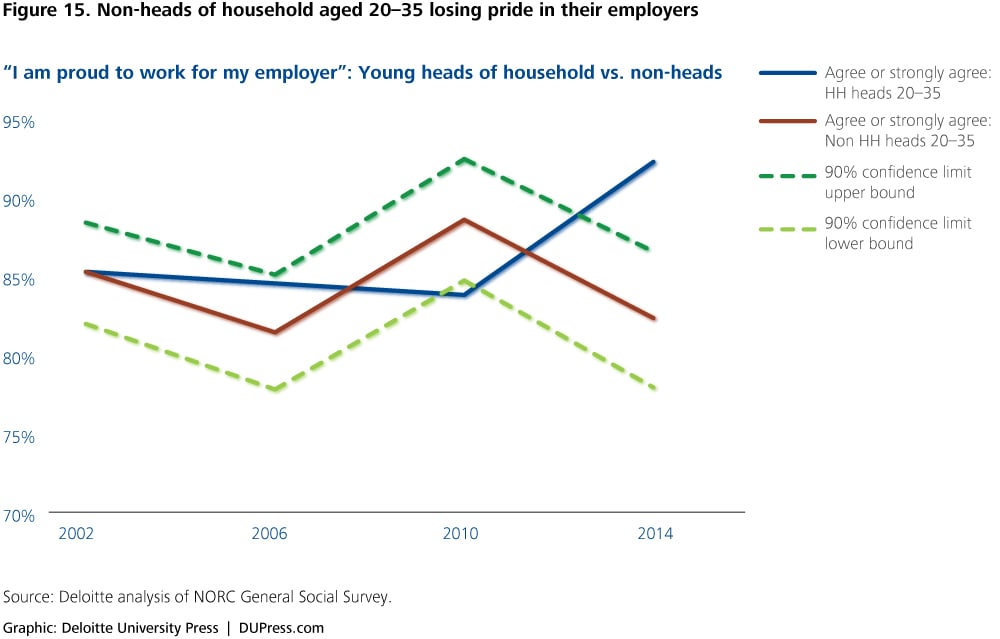
Creating a nuanced human capital strategy for Millennial workers
Instead of believing the myth that Millennials are fundamentally harder to recruit, engage, and retain than other generations, organizations can leverage a more sophisticated understanding of Millennials to improve performance on key workforce indicators. To do so, organizations should try to clearly understand which Millennial traits represent true generational differences and which ones are mutable and result from external factors. Key to improving the relationship between an organization and its Millennial workers is to treat them, not as a homogeneous block, but as a set of differentiated segments defined by their life milestones. Employers’ efforts to forge better and longer-lasting bonds with Millennials should recognize and focus on the particular challenges they face in achieving these milestones.
An important area to consider for new and expanded Millennial workforce programs is the problem of education and student debt. Employers can consider expanding and diversifying their incentives by addressing student debt and highlighting these programs in recruitment and compensation programs. Many organizations already offer some kind of tuition assistance for employees pursuing higher education degrees (although in many cases, tuition assistance is a one-size-fits-all program). More and more organizations, for instance, are starting Loan Repayment Assistance Programs (LRAPs). LRAPs have been shown to have improved recruitment and retention for hard-to-fill occupations such as public assistance lawyers26 and teachers in rural districts—though with varying degrees of success.27
Another challenge for Millennial workers is housing. Rising home prices in the cities most attractive to Millennials have made first-time homeownership out of reach for many, forcing many to put off household formation.28 While many organizations already have housing purchase assistance programs for top executives, those facing Millennial staffing shortages may wish to expand these programs to include employees at all levels. Evidence is beginning to accumulate for the positive effects of such programs on building employee loyalty.29 For organizations unable to afford such programs, offering credit and home ownership counseling can be a low-cost complementary option. Finally, organizations considering relocation or expansion projects would be wise to put Millennial housing costs high on their list of factors to prioritize.
Transportation is a final challenging area for Millennials that can offer opportunities to creative employers. Today, many employers are developing a host of innovative programs to encourage and reward employees for particular transportation choices. Some employers now offer parking subsidy cash-out benefits for employees who carpool or ride public transit to work. Other employers are developing programs to support bike commuting through physical improvements to offices and equipment incentive programs. Robust telework programs give employees the flexibility to avoid commuting headaches altogether. Close partnerships between municipal governments and local employers can foster better local transit and housing options for Millennial employees.30
As employers develop these programs and tie them to recruitment, engagement, compensation, or retention strategies, they should remember that a segmented approach is likely to increase the benefits. Millennials who already own a home and are thinking about starting a family may want to take advantage of one mix of incentives, while Millennials who are still paying off student loan debt and living with their parents may find a different set of benefits appealing.
Case study: Millennials in government
Federal, state, and local governments have been particularly worried over the past several years about recruiting and retaining Millennial workers. Government workforces are greying, and the latest figures from the Bureau of Labor Statistics show that Millennials make up only 24.5 percent of government employees, compared to 33.7 percent in the private sector.31 The bursting of the housing bubble, the Great Recession, and political infighting in Congress have all severely limited the funding available for governments to hire and develop young workers.
This worry has become more acute because of the conventional wisdom that Millennials are not interested in staying in the same job for their whole career. If Millennials are not motivated by the promise of a stable job and a good pension in 30 years, the thinking goes, how can government agencies attract and motivate these critical young workers?
The realization that much of the conventional wisdom about Millennials is based on misconceptions can allow governments to tailor their human capital strategies to the realities of the Millennial workforce, improving the results.
For a full discussion of our research on Millennials in federal, state, and local governments, we invite you to read a forthcoming companion piece to this report that looks more closely at the behavior of Millennials in public service.32 Our analysis of a broad range of new data examines four common beliefs about Millennials who work for government: that they have high turnover rates; that they are less passionate about government careers than other generations; that, once hired, they are more likely to leave government for the private sector; and that it is more difficult to recruit Millennials into government jobs than it was to recruit prior generations. To test all four pieces of conventional wisdom, we use quantitative data on Millennials’ behavior in the workforce to show which beliefs are true and which need revision.
Our findings suggest that, as governments loosen up the reins on hiring, Millennials will begin to flow into government jobs as naturally as did Gen Xers. Targeted recruitment efforts and innovative employee development programs can help overcome some of the particular circumstances Millennials face. For example, Pennsylvania has a successful state internship program for college graduates to fill its IT needs.33
Different, or just young? A little of both
As we have seen, Millennials are different from older generations in several ways. As a group, they are more highly educated. They are more likely to have student loan debt, and more of it, than their elders did at the same age. And they were hardest hit during the Great Recession in terms of unemployment; even now, younger workers have higher unemployment rates than do those aged 35 and over.
Yet many other perceived differences between Millennials and previous generations are just that: perceived rather than actual. If Millennials live with their parents for a relatively long time and are slower to buy cars and homes, it is likely due more to the economic circumstances under which they began their working lives than to differences in their underlying preferences. Our research shows that Millennials may come late to family and homeownership, but once they do, their behavior resembles that of older generations more closely than many may realize. And evidence suggests that their supposed “lack of loyalty” to employers may be an artifact of their incomplete entry into the labor force.
All in all, in many ways, Millennials are behaving just as they might be expected to, given the economic circumstances under which they came of age. It behooves employers to better understand this generation and the various life goals to which they aspire, and craft tailored interventions aimed at engaging this vital segment of the workforce.
All in all, in many ways, Millennials are behaving just as they might be expected to, given the economic circumstances under which they came of age.
Major challenges for workforce planning include recruiting, retention, organization design, learning development, compensation, and benefits. Deloitte’s integrated approach provides insight into which talent segments deliver high returns and need greater investment. To help make it happen, Deloitte Consulting offers services in the following areas:
- Talent management
- HR technology
- Workforce analytics
- Demand planning
- Labor economic
© 2021. See Terms of Use for more information.



